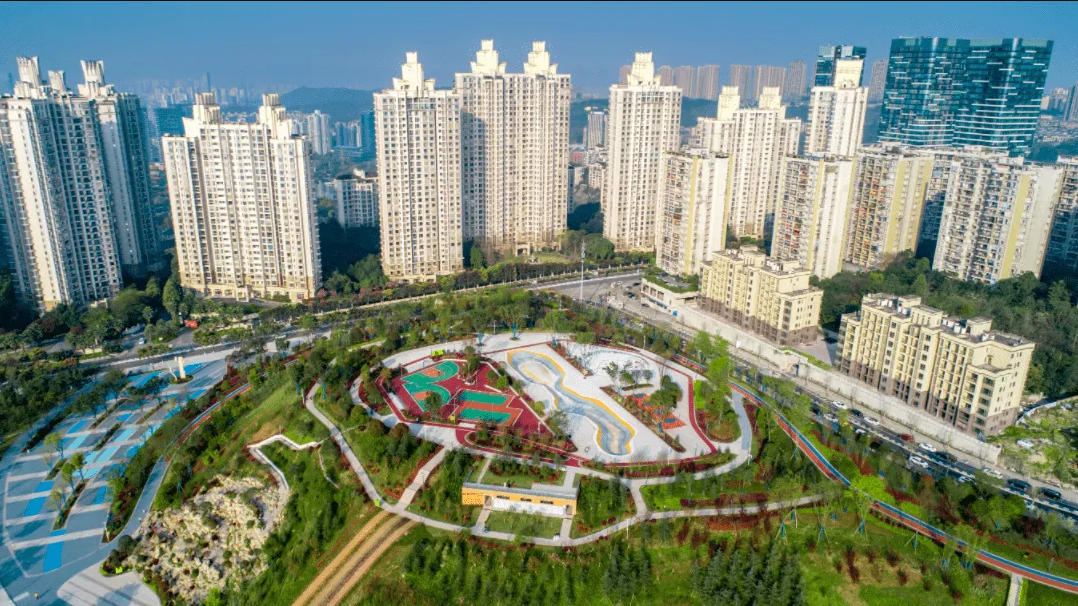Chongqing — The city has launched construction on 88 pocket parks this year, with 64 completed as of the end of June, according to the Chongqing Municipal Bureau of Urban Management. The completed parks are already serving an estimated 1.14 million residents.
Pocket parks—small-scale, publicly accessible green spaces—are part of Chongqing's broader initiative to advance Chinese modernization, focusing on people's well-being, a national development principle that prioritizes quality of life and inclusive urban growth.
Since 2023, these compact parks, which may include mini playgrounds, landscaped seating areas, and recreational facilities, have been featured in the city’s Key Practical Initiatives for Improving People’s Livelihoods. The 2025 plan calls for the construction of 100 pocket parks and 10 sports parks across the municipality.

On July 19, in Mutao Road Community Park, Tian Gongdian Subdistrict, Liangjiang New Area, residents exercised outdoors (Photo/Long Fan)
One recently completed project, the Shancheng Lane Ecological Park in Yuzhong District, opened in April. The park is designed for all ages and includes badminton courts, table tennis tables, and children’s play equipment such as swings and slides. A prominent 89-meter “City Memory Wall” displays historical and contemporary images of the neighborhood, highlighting the area’s transformation.
“This site was previously just a sloped pathway with overgrown vegetation and no usable facilities,” said Chu Mei, deputy chief of engineering at the Yuzhong District Greening Management and Maintenance Office. “We preserved mature trees, cleared overgrowth, and introduced flowering species like cherry blossoms and hydrangeas to create a layered landscape.”
Wang Haomin, director of the Parks Division at the Chongqing Municipal Bureau of Urban Management, described the city’s approach as “retain, refine, and enhance” — preserving existing greenery, reorganizing spatial layouts, and adding functional amenities. “The goal is for residents to see greenery from their windows, walk into a park in minutes, and enjoy nature throughout the city,” he said.

The sports park at Renhe Street, Chongqing Liangjiang New Area, is a great example of how the city transformed a wasteland into public spaces that meet the residents' various demands. (Photo/Zhang Kunkun)
Chongqing is also expanding access to physical activity through sports parks. In Liangjiang New Area, the Mountain Sports Park features basketball and badminton courts and a 70-meter hillside adapted into a rock-climbing facility with routes tailored to different age groups. Fengxi Lake Sports Park has become a popular destination for after-work exercise in the High-tech Industrial Development Zone.
“The new facilities make it easier for people to stay active close to home,” said Zhang Yun, an employee of a nearby research institute. “The environment is great, and it’s just across the street.”
The city plans to complete 13 sports parks this year. Three of them were completed in April in Jiangjin District and Wuxi County.
Chongqing’s pocket parks are designed not only for recreation, but also to reflect local character and culture. In Mutao Road Community Park, wooden benches overlook a nearby rail tunnel where trains pass by every few minutes.
In Lailusi Pocket Park, located in Jiangbei District’s Shimahe Subdistrict, interpretive panels share the story of Jian Yi, a Ming dynasty official who once lived in the area. Other displays focus on civic values and community history.“We’re moving beyond standard park design,” said Director Wang. “Each pocket park is meant to serve both practical and cultural needs of its neighborhood.”
The project follows the 2025 Chongqing Implementation Plan for Pocket Park Construction, which emphasizes ecological sustainability, inclusive design, and alignment with the city’s 15-minute community life circle strategy—a model that aims to ensure all essential services, including green space, are within a 15-minute walk from residents’ homes.
The guidelines also call for the use of energy- and water-efficient materials, barrier-free access, and community participation in planning.
With 64 parks completed and dozens more underway, Chongqing’s pocket park initiative is on track to meet its goals—reshaping urban life, one green space at a time.
By continuing to browse our site you agree to our use of cookies, revised Privacy Policy and Terms of Use. You can change your cookie settings through your browser.
For any inquiries, please email service@ichongqing.info